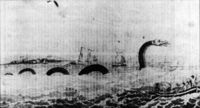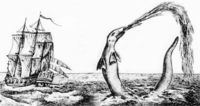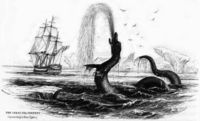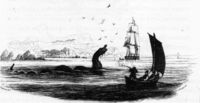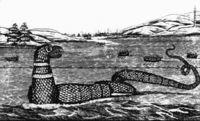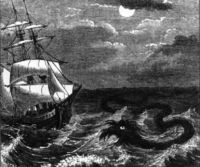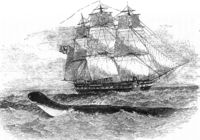Sea serpents are a kind of sea monster either wholly or partly serpentine. Despite the numerous sightings, though, no credible physical evidence has been recorded and it is currently believed that the serpents do not actually exist.
History/Beliefs
Mythology
- The Tanakh contains references to Leviathan and Rahab, both Biblical sea serpents.
- In Norse mythology, Jörmungandr, or "Midgårdsormen" was a sea serpent so long that it encircled the entire world, Midgard. Some stories report of sailors mistaking its back for a chain of islands. Sea serpents also appear frequently in later Scandinavian folklore, particularly in that of Norway.
Sightings
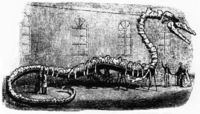
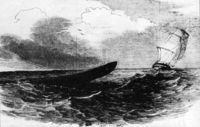

- Sightings have been reported for hundreds of years, and recent work by Bruce Champagne indicates that there have been 1,200 or more all told. Sea serpents have been seen from both ship and shore, and by multiple people at once, groups that sometimes count scientists among their number. In many cases, these sightings are well documented in the newspapers of the day, although most occurred before any kind of photographic technology existed.
- In Swedish ecclesiastic and writer Olaus Magnus's Carta marina, many marine monsters of varied form, including an immense sea serpent, appear. Moreover, in his 1555 work History of the Northern Peoples, Magnus gives the following description of a Norwegian sea serpent:
Those who sail up along the coast of Norway to trade or to fish, all tell the remarkable story of how a serpent of fearsome size, 200 feet long and 20 feet wide, resides in rifts and caves outside Bergen. On bright summer nights this serpent leaves the caves to eat calves, lambs and pigs, or it fares out to the sea and feeds on sea nettles, crabs and similar marine animals. It has ell-long hair hanging from its neck, sharp black scales and flaming red eyes. It attacks vessels, grabs and swallows people, as it lifts itself up like a column from the water.
- In the 19th century there were several major sea serpent sightings on the Gloucester and Maine coasts of New England, which spawned a rather silly mix-up. On August 18, 1817, a meeting of the New England Linnaean Society went so far as to give a deformed terrestrial snake the name Scoliophis atlanticus (thinking it was the juvenile form of a sea serpent that had recently been seen nearby). After the Linnaean Society's misidentification was discovered, it was frequently cited by debunkers as evidence that the creature did not exist; when in fact, the only thing proven by the incident was that the Society had made an embarrassing public error.
- A particularly famous sea serpent sighting was made by the men and officers of HMS Daedalus in August, 1848 during a voyage to Saint Helena in the South Atlantic; the creature they saw, some 60 feet long, held a peculiar maned head above the water. The sighting caused quite a stir in the London papers, and Sir Richard Owen, the famous English biologist, proclaimed the beast an elephant seal. The Daedalus' serpent has since been classified as a Super Eel or Type 2C animal. Another skeptical suggestion for the sighting proposed that it was actually an upside down canoe, or a posing giant squid.
- On Saturday 30 May 1903, the SS Tresco was cruising 90 miles south of Cape Hatteras when Joseph Ostens Grey, the ship's Second Officer, spotted what he first thought was a derelict hulk in the water. On closer examination they realized it was no wreaked ship:
- "With a conviction that grew deeper, and ever more disquieting, we came to know that this thing could be no :derelict, no object that hand of man had fashioned..." reported Grey. He described a head that emerged out :of water on a tall and powerful neck. It was "dragon-like" and accompanied a body some 100 feet in length :and eight feet across at the widest. The head was five feet long and eighteen inches in diameter.
- There was concern that the ship, running light without cargo, might be tipped and overturned if the :creature attempted to clamber aboard.
- "Presently I noticed something dripping from the ugly lower jaw," continued Grey, "Watching, I saw that it :was saliva, of a dirty drab color, which dripped from the corners of the mouth." Eventually the creature :turned away and the danger was averted.|}
- Another sighting took place in 1905 off the coast of Brazil. The crew of the Valhalla and two naturalists, Michael J. Nicoll and E. G. B. Meade-Waldo, saw a long-necked, turtle headed creature, with a large dorsal fin. Based on its dorsal fin and the shape of its head, some experts (such as Heuvelmans) have suggested that the animal was some sort of marine mammal. It has since been classified as a Super Eel (without good justification) or Type 4B. A skeptical suggestion is that the sighting was of a posing giant squid, but this is hard to accept given that squids do not swim with their fins or arms protruding from the water.
- On April 25, 1977, the Japanese trawler Zuiyo Maru, sailing east of Christchurch, New Zealand, caught a strange, unknown creature in the trawl. Photographs and tissue specimens were taken. While initially identified as a prehistoric plesiosaur, analysis later indicated that the body was most likely the carcass of a basking shark.
- On November 1st, 1983, a construction crew was working on Route 1 just north of the Golden Gate Bridge near Stinson Beach. Suddenly they spotted a creature, underwater, approaching the land. They estimated the creature's length at 100 feet and it's diameter at five. Using binoculars they watched it making coils, throwing it's head about and whipping it's body around.
- Sea serpent sightings continue today, with reports coming in from the Pacific Northwest and California; the most notable of recent occurrences is the alleged filming of sea serpents in 1985 by the brothers Bill and Bob Clark in San Francisco bay. They watched two seals swimming extremely fast across the bay. Then they noticed a "large black snake-like" animal" chasing the seals. They saw that the creature moved by forming it's body into coils and wiggling up and down. The animal apparently also had small, translucent fan-like fins that acted as stabilizers.
- In October 2004, the giant squid, long associated with sea monsters and perhaps the source of many mistaken sightings, was for the first time caught on video off the Bonin Islands, revealing for the first time the appearance in life of this "cousin" of sea serpents.
Theories and analysis
- Skeptics and debunkers have questioned the interpretation of sightings, putting forward in place of serpents cetaceans (whales and dolphins), sea snakes, eels, basking sharks, baleen whales, oarfish, large pinnipeds, seaweed, driftwood, a wave phenomenon, flocks of birds, and giant squid as the creature or creatures seen (see Notable Cases, above, on giant squid and basking sharks).
- While most cryptozoologists recognize that at least some reports are simple misidentifications, they point out that many of the creatures described by those who have seen them look nothing like the known species put forward by skeptics and claim that certain reports stick out. For their part, the skeptics remain unconvinced, pointing out that even in the absence of out-right hoaxes (such as the infamous "Surgeon's Photo" of the Loch Ness Monster), imagination has a way of twisting and inflating the slightly out-of-the-ordinary until it becomes extraordinary.
Classification systems
Cryptozoologists may further argue for the existence of sea serpents by pointing out that people see similar things, and it is possible for them to classify the different "types". While there have been different classification attempts with different results, they all share several common characteristics.
Anthonid Cornelis Oudemans
- Megophias megophias : A large (200+ feet) sea lion-like creature with a long neck and long tail. Only the male has a mane. It is cosmopolitan.
Bernard Heuvelmans
- Long Necked or Megalotaria longicollis: A 60 foot, long necked, short tailed sea lion. Hair and whiskers reported. Cosmopolitan. Interestingly, a long necked seal is now known from the fossil record.
- Merhorse or Halshippus olai-magni: A 60 foot, medium necked, large eyed, horse-headed pinniped. Often has whiskers. It is also cosmopolitan.
- Many-Humped or Plurigibbosus novae-angliae: A 60-100 foot, medium necked, long bodied archaeocete. It has a series of humps or a crest on the spine like a sperm whale's or grey whale's. It only lives in the North Atlantic.
- Super Otter or Hyperhydra egedei: A 65-100 foot, medium necked, long bodied archeocete that resembles an otter. It moves in numerous vertical undulations (6-7). Lived near Norway and Greenland, and presumed to be extinct by Heuvelmans.
- Many Finned or Cetioscolpenda aelani: A 60-70 foot, short necked archeocete. It has a number of lateral projections that look like dorsal fins, but turned the incorrect way. Compare to the armor on Desmatosuchus, but much more prominent.
- Super Eels: A group of large and possibly unrelated eels. Partially based on the Leptocephalus giganteus larvae, later shown to be normal sized. [This is a controversial identification of a larval specimen made without benefit of actually examining the specimen. This "identification" was done by the paperwork and the actual specimen was missing by then.] Heuvelmans theorized eel, synbranchid, and elasmobranch identities as being possible. Cosmopolitan.
- Marine Saurian: A 50-60 foot crocodile, or crocodile-like animal (Mosasaur, Pliosaur, etc)
- Yellow Belly: A very large (1-200 foot) yellow and black striped tadpole-shaped creature. Dropped.
- Father-of-all-the-turtles: A giant turtle. Dropped
- Giant Invertebrates: Giant venus's girlde and salp colonies. Added. It is not clear if Heuvelmans intended them to be known species or extreme forms of known species.
Loren Coleman and Patrick Huyghe
- Classic Sea Serpent: A quadrupedal, elongated animal with the appearance of many humps when swimming. Essentially a composite of the many humped, super otter, and super eels types. The authors suggest Basilosaurus as a candidate, or possibly Remingtoncetids.
- Waterhorse: A large pinniped, similar to the long necked and merhorse. Only the males are maned, but females appear to have snorkels. Both of their eyes are rather small. They are noteworthy for being behind both salt and fresh water sightings.
- Mystery Cetacean: A category of unknown whale species including double finned whales and dolphins, dorsal finned sperm whales, unknown beaked whales, an unknown orca, and others.
- Giant Shark: A surviving Megalodon.
- Mystery Manta: A small manta ray with dorsal markings.
- Great Sea Centipede: Same as the many finned. The authors suggest the flippers may either be retractile, and the "scaly" appearance could be caused by parasites.
- Mystery Saurian: Same as the marine saurian.
- Cryptic Chelonian: A resurrection of the father-of-all-turtles.
- Mystery Sirenian: Late surviving Steller's Sea Cow.
- Giant Octopus, Octopus giganteus or Otoctopus giganteus: A large cephalopod living in the tropical Atlantic.
Bruce Champagne
- 1A Long Necked: A 30 foot sea lion with a long neck and long tail. The neck is the same thickness or smaller than the head. Hair reported. It is capable of travel on land. Cosmopolitan.
- 1B Long Necked: Similar to the above type but over 55 feet long and far more robust. The neck is of lesser thickness than the head. Only inhabits water near Great Britain and Denmark.
- 2A Eel-Like: A 20-30 foot long heavily scaled or armored reptile. It is distinguished by a small square head with prominent tusks. "Motorboating" behavior on surface. Inhabits only the North Atlantic.
- 2B Eel-Like: A 25-30 foot beaked whale. It is distinguished by a tapering head and a dorsal crest. "Motorboating" behavior engaged in. Inhabits the Atlantic and Pacific. Possibly extinct.
- 2C Eel-Like: A 60-70 foot, elongated reptile with no appendages. The head is very large and cow-like or reptilian with teeth similar to a crabeater seal's. Also shares the "motorboating" behavior. Inhabits the Atlantic, Pacific, and South China Sea. Possibly extinct.
- 3 Multi-Humped: 30-60 feet long. A possible reptile with a dorsal crest and the ability to move in several undulations. The head has a distinctive "cameloid" appearance. Identical with Cadborosaurus willsi and is behind the Naden Harbor carcass.
- 4A Sailfin: A 30 to 70 foot beaked whale. It is distinguished by a very small head and a very large dorsal fin. Only found in the North West Atlantic. Possibly extinct.
- 4B Sailfin: An elongated animal of possible mammalian or reptilian identity reported from 12 to 85 feet long. It has a long neck with a turtle-like head and a long continuous dorsal fin. Cosmopolitan.
- 5 Carapaced: A large turtle or turtle-like creature (mammal?) reported from 10 to 45 feet long. Carapace is described as jointed, segmented, and plated. May exhibit a dorsal crest of "quills" and a type of oily hair. Cosmopolitan.
- 6 Saurian: A large and occasionally spotted crocodile or crocodile-like creature up to 65 feet long. Found in the Northern Atlantic and Mediterranean.
- 7 Segmented/Multi limbed: An elongated mammalian creature up to 65 feet long with the appearance of segmentation and many fins. Found in the Western Atlantic, Indian, and Pacific.
External links
- mjoesormen.no, database of Norwegian sea serpents
- The Cryptid Zoo: Sea Serpents
- Cadborosaurus and the Naden Harbour carcass
- Swan necked seals
Sources
- Bruce Champagne. A Preliminary Evaluation of a Study of the Morphology, Behavior, Autoecology, and Habitat of Large, Unidentified Marine Animals, Based on Recorded Field Observations. Available at strangeark. Pages 99-118
- Loren Coleman and Patrick Huyghe. The Field Guide to Lake Monsters, Sea Serpents, and Other Mystery Denizens of the Deep. Jeremy P. Tarcher 2003.
- Bernard Heuvelmans. In the Wake of the Sea-Serpents. Hill and Wang 1968
- A. C. Oudemans. The Great Sea Serpent. Luzac & Co 1892. Available at strangeark


